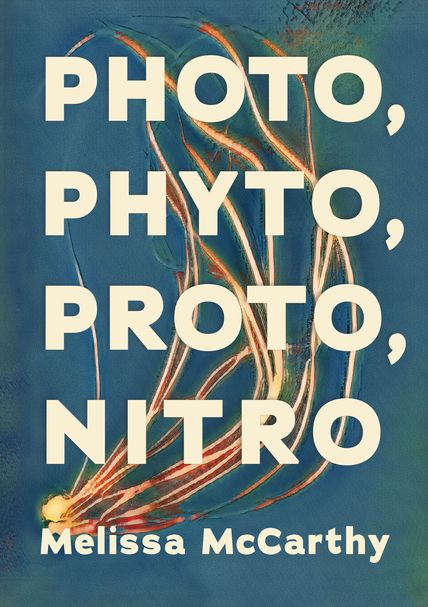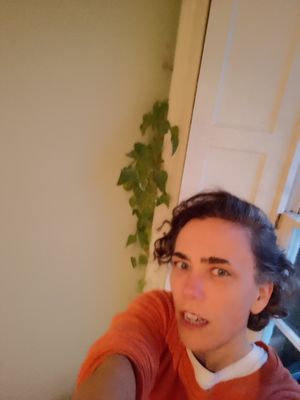
Photo: to do with light. Phyto: plants and flowers. Proto: the first, the original. Nitro: it blows up.
From Troy to Hiroshima, Crimea to the nuclear Nevada desert, we make our tracks over the war-scratched globe, and when we reach a ruin or a destination we read the markings, record them using various forms of photography. Later—or much, much later—someone else in turn will try to understand our silvery traces. These are the threads that Melissa McCarthy follows, unpicks, weaves again into a nexus of light and time: the mirrored silver cells of a shark’s eyeball, sunlight glinting off the foam and sea wrack of the Aegean on flower with corpses, the silver salts of photographic paper, silver grave-treasures at Ur.
Like an archaeologist in her own strange literary landscape, McCarthy cuts through layers of history and technology to realign the dead and their images. She examines both what can be photographed and what remains always just beyond the frame, and photography itself. It’s a practice involving chemicals and the action of light. But it’s also an organising principle for literature and beyond: there are marks made—by us, on us—that we can’t yet fully see or understand, though they push on through to the surface, always re-blooming.
Notices
“Four dazzling essays about images, destruction, flowers and invention, forging unexpected links between Agamemnon, archaeology, early photography, explosives, neuroscience, mirrors, Twin Peaks, and—the author’s special interest—sharks. (Did you know that sharks see everything twice?) Melissa McCarthy combines a sharp, precise intelligence with great warmth, wit and sensitivity; her brilliant monograph is sure to become a durable classic.”
—David Collard, author of Multiple Joyce
“In Photo, Phyto, Proto, Nitro Melissa McCarthy mixes her four headline prefixes in the crucible of her wit to capture the endless interactions in nature and art of destruction, flowers, images, and invention. Like Montaigne writing about the destruction of the Aztec empire, McCarthy constructs her text as a vehicle in which to move across the corpse-strewn wastelands and oceans of human history, gathering together the images that survive and the flowers that unconscionably bloom. The result is an extraordinary feat of quizzical, inquisitive invention, an essay that never stops moving.”
—Professor Richard Scholar, author of Émigrés: French Words That Turned English
“McCarthy asks, How do we picture the world? Her answer is: Metaphorically, one thing in terms of another, and then another. And so she writes a beguiling microcosm of a book which, like the ‘aleph’ of Borges, contains everything: from Agamemnon to algae, from Hiroshima to Hergé, and not omitting the inside of a shark’s eyeball.”
—Dr. Andy Martin, author of Surf, Sweat and Tears and Reacher Said Nothing
“From Aeschylus to Jaws, via histories of photography, tattoos, chemicals and some of the most horrific moments of the twentieth century, Melissa McCarthy’s Photo, Phyto, Proto, Nitro reads like the reed mats dug up from a Sumerian city: an assemblage of lightly woven textured texts, ‘crumbling as we try to consider them’. McCarthy approaches writing as a generous reader, as a detective, as a rummager among archives, as an archaeologist, as a photographic developing agent. The book is suffused with the pleasure of looking and finding and showing and sharing. McCarthy has a way of recalibrating perception, finding the depth in a surface and surfaces in the depths, helping you to see for just a fleeting moment that perhaps yes a camera is also a coffin, and a shark is also a camera. The result is forensic, joyful, surprising and rich. As McCarthy herself writes repeatedly, ‘This is great’ and ‘I love this’.”
—Tom Jeffreys, author of The White Birch: a Russian Reflection
“In this sequel to her amazing Sharks, Death, Surfers, Melissa McCarthy shifts the focus to photography and, as its jingle title advertises, makes completely new stopovers and connections that indelibly change how we look at and through the medium. While it participates in what is by now a genre of study of our deep attachment to the vestige, her contribution doesn’t get lost there. By offering rigorous reinterpretation of the photographic image’s posttraumatic temporality (from its lurking latency to its potent efflorescence, which in the end happens only to recur) McCarthy’s analysis situates not the history but the essence of the medium within its near miss with doubling.”
–Laurence Rickels, author of Critique of Fantasy
“PPPN follows its trails of argument precisely—every detail mentioned is vital as it will be returned to, and looked at again in a sharper light or from a different angle or in a new context, bringing each element and the whole they form into clearer focus and relief each time. McCarthy’s style is clear, even when dealing with complex subject matter (the interior of a shark’s eye, for example), and moves smoothly between lucid academic and casually friendly. There is nothing de haut en bas here, only the dazzling pleasure of being with an incredibly sharp, wide-ranging and well-informed mind as it thinks. McCarthy asks us along, inviting us to explore the worlds of cyanotypes, sharks, nitrates and memory books (among other things) together…. Anyone seriously interested in photography should place this book alongside Barthes’ Camera Lucida and Geoff Dyer’s The Ongoing Moment on their shelves.”
—C. D. Rose, in 3:AM Magazine
